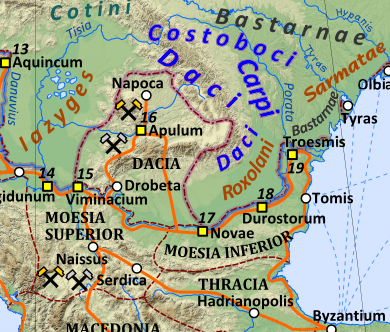
The Bastarnae, Bastarni or Basternae, also known as the Peuci or Peucini, were an ancient people who are known from Greek and Roman records to have inhabited areas north and east of the Carpathian mountains between about 300 BC and about 300 AD, stretching in an ark from the sources of the Vistula in present day Poland and Slovakia, to the Lower Danube, and including all or most of present day Moldava. The Peucini were sometimes described as a subtribe, who settled the Peuke Island in the Danube Delta, but apparently due to their importance their name was sometimes used for the Bastarnae as a whole. Near the sources of the Vistula another part of the Bastarnae were the Sidones, while the Atmoni, another tribe of the Bastarnae are only mentioned in one listing by Strabo.
The earliest Graeco-Roman historians to refer to the Bastarnae imply that they were culturally Celtic. Also consistent with connections to the cultures to their west, later Roman-era sources state directly that they spoke Germanic languages, and could be considered Germanic peoples. In contrast, like other peoples who lived in this geographical region, Graeco-Roman writers also sometimes referred to the Bastarnae as a "Scythian" or "Sarmatian" people, but this was a reference to their location, and customs, rather than a linguistic category. Although largely sedentary, at least one Roman writer, Tacitus, stated that the Bastarnae had adopted some Sarmatian customs. So far, no archaeological sites have been conclusively attributed to the Bastarnae. The archaeological horizon most often associated by scholars with the Bastarnae is the Poieneşti-Lucașeuca culture.
From the first records which mention them, the Bastarnae were active in the region of the Danube estuary on the Black Sea coast. The Bastarnae first came into conflict with the Romans during the first century BC when, in alliance with Dacians and Sarmatians, they unsuccessfully resisted Roman expansion into Moesia and Pannonia, south of the Danube. Later, they appear to have maintained friendly relations with the Roman Empire during the first two centuries AD. This changed around 180 AD, when the Bastarnae are recorded as participants in an invasion of Roman territory, once again in alliance with Sarmatians and Dacians. In the mid-3rd century AD, the Bastarnae were part of a Gothic-led grand coalition of lower Danube tribes that repeatedly invaded the Balkan provinces of the Roman Empire.
Many Bastarnae were resettled within the Roman Empire in the late third century.